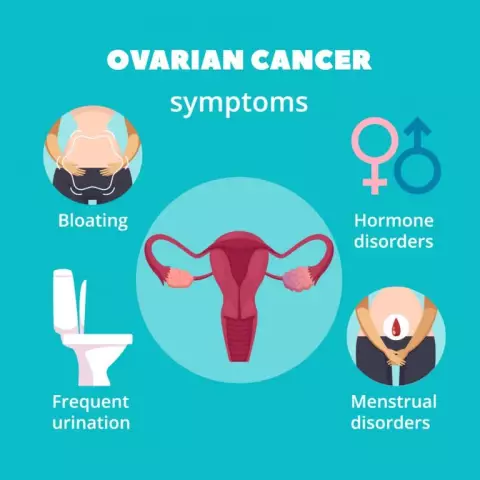- Author Rachel Wainwright [email protected].
- Public 2023-12-15 07:39.
- Last modified 2025-11-02 20:14.
Ovarian cancer
General characteristics of the disease

Ovarian cancer is a common and aggressive cancer. It confidently ranks 5th in the number of cases of oncology of various organs among women. The most common form of epithelial ovarian cancer. Much less often, malignant pathology develops inside an organ from the so-called germ cells.
Ovarian cancer is rarely diagnosed in women younger than 40. There is a relationship between the manifestation of signs of ovarian cancer and hormonal imbalance. The risk group includes nulliparous women, as well as patients with 5 or more pregnancies. Women with a family history of ovarian or breast cancer are at increased risk of developing ovarian cancer. At the same time, 5-year continuous use of contraceptive pills can reduce the likelihood of developing ovarian cancer by almost 50%.
Ovarian cancer symptoms
Early onset ovarian cancer is usually asymptomatic. Later, at the stage of an increase in the tumor and the spread of metastases of ovarian cancer, a woman develops pain in the lower abdomen, weakness. An additional symptom of ovarian cancer at this stage is weight loss. In this case, the size of the patient's abdomen is continuously increasing. The initial enlargement of the abdomen provokes the growth of the tumor and its spread to the fatty abdominal tissue - the omentum. In the late stage of ovarian cancer, a sign of the disease and the cause of an increase in the size of the abdomen is ascites - the accumulation of fluid behind the peritoneum.
Early symptoms of ovarian cancer are often non-systemic. The first signs of ovarian cancer are often taken by the patient herself for the manifestation of the inflammatory process in the ovaries - adnexitis.
With the spread of metastases of ovarian cancer or the tumor itself to the intestine, symptoms of ovarian cancer become indigestion, constipation, tenesmus, intestinal obstruction. Metastases of ovarian cancer that have spread to the bones, brain and other organs and systems have even more extensive symptoms: thinning bones, fractures, various neurological disorders, etc.
Ovarian cancer stages

The stage of ovarian cancer depends on the size of the tumor, the presence and location of ovarian cancer metastases in the body. Preoperative staging of ovarian cancer can only be preliminary. An accurate diagnosis is established during intraoperative revision.
In stage I ovarian cancer, the signs of the disease are the location of the tumor within one ovary. At stage IB ovarian cancer, the tumor spreads to the second paired organ. In stage IC ovarian cancer, the ovarian capsule may be damaged.
Stage II is characterized by the following symptoms: ovarian cancer has spread to the fallopian tubes or uterus (IIA), to other organs of the pelvis (IIB). In stage IIC ovarian cancer, there are malignant cells in the abdominal fluid.
Ovarian cancer metastases outside the pelvis are typical for stage III of the disease. They can be located in nearby and remote lymph nodes, as well as in various organs.
Ovarian Cancer Diagnosis
Early diagnosis of the disease is the key to successful treatment of ovarian cancer. With the primary complaints, the patient usually turns to her gynecologist. After a vaginal examination on a chair, taking smears, blood tests for oncological markers and ultrasound examination of the pelvic organs, a woman is sent to a narrower specialist - a gynecological oncologist.
In the differential diagnosis of ovarian cancer, he uses a more accurate ultrasound technique using trans-abdominal transducers. The standard for determining the extent of the spread of intestinal cancer metastases is computed tomography, chest x-ray, as well as gastro- and colonoscopy. Cytological or histological confirmation of the type of ovarian cancer is possible by laparoscopy, in which the tissue and fluid of the peritoneum is taken from the patient under anesthesia through a small incision in the abdomen.
Ovarian cancer treatment

Treatment for ovarian cancer is usually combined. It consists of radical removal of the tumor, radiation and chemotherapy. Postoperative chemoradiation procedures are the usual standard in ovarian cancer treatment. They can significantly reduce the likelihood of tumor recurrence and the development of metastases of ovarian cancer.
If there is a significant spread of ovarian cancer metastases or large tumor sizes, the oncologist may refer the patient to preoperative chemotherapy and radiation exposure. An operation to remove the tumor in this case is prescribed only after the tumor reaches an operable size.
The radicality of the operation depends on the stage of the ovarian cancer. With a small tumor and the absence of metastases of ovarian cancer, minimally invasive organ-preserving surgery is possible. In the later stages of ovarian cancer, an abdominal operation is usually performed with the complete removal of both ovaries, the omentum and uterus, as well as all foci of metastasis.
Postoperative control after treatment for ovarian cancer is carried out for 3-5 years with regular examinations by a gynecological oncologist and blood tests for CA-125 cancer markers.
YouTube video related to the article:
The information is generalized and provided for informational purposes only. At the first sign of illness, see your doctor. Self-medication is hazardous to health!






